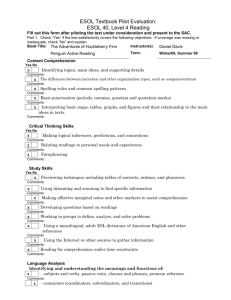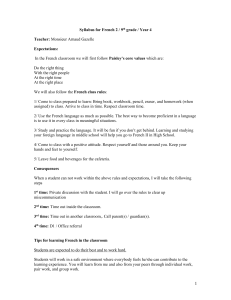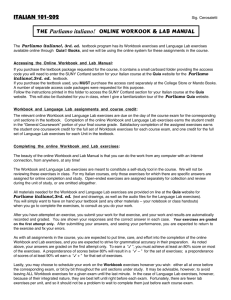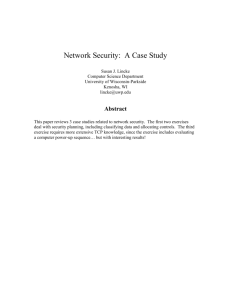LNGT 0250: Morphology and Syntax Spring 2015 Assignment #5
advertisement
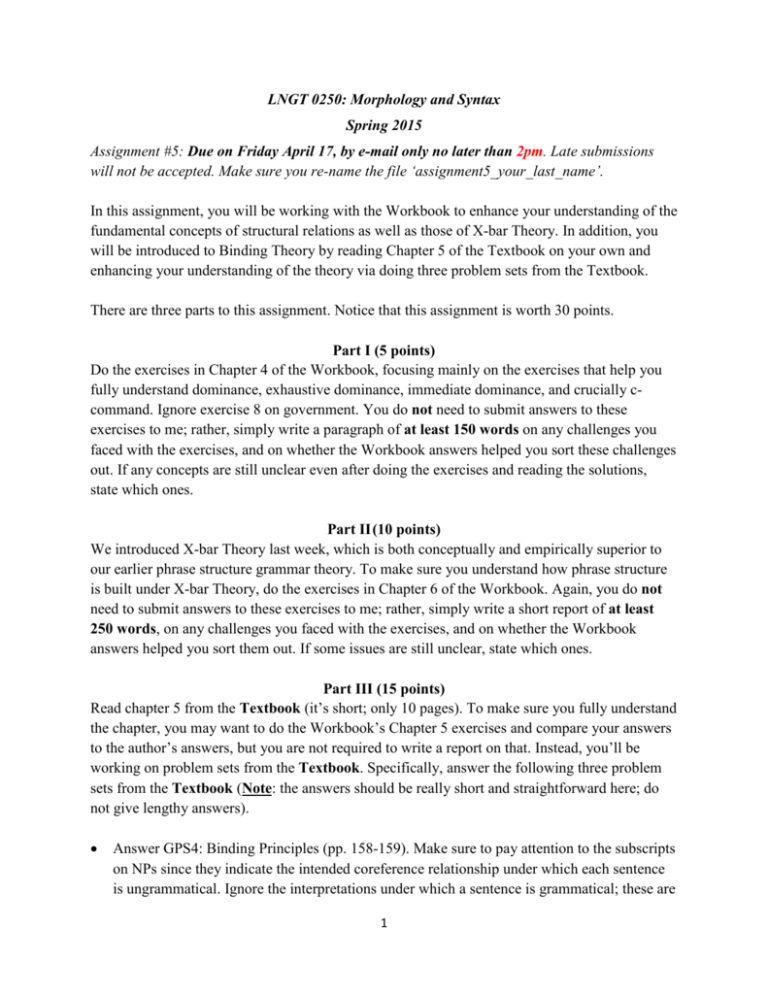
LNGT 0250: Morphology and Syntax Spring 2015 Assignment #5: Due on Friday April 17, by e-mail only no later than 2pm. Late submissions will not be accepted. Make sure you re-name the file ‘assignment5_your_last_name’. In this assignment, you will be working with the Workbook to enhance your understanding of the fundamental concepts of structural relations as well as those of X-bar Theory. In addition, you will be introduced to Binding Theory by reading Chapter 5 of the Textbook on your own and enhancing your understanding of the theory via doing three problem sets from the Textbook. There are three parts to this assignment. Notice that this assignment is worth 30 points. Part I (5 points) Do the exercises in Chapter 4 of the Workbook, focusing mainly on the exercises that help you fully understand dominance, exhaustive dominance, immediate dominance, and crucially ccommand. Ignore exercise 8 on government. You do not need to submit answers to these exercises to me; rather, simply write a paragraph of at least 150 words on any challenges you faced with the exercises, and on whether the Workbook answers helped you sort these challenges out. If any concepts are still unclear even after doing the exercises and reading the solutions, state which ones. Part II (10 points) We introduced X-bar Theory last week, which is both conceptually and empirically superior to our earlier phrase structure grammar theory. To make sure you understand how phrase structure is built under X-bar Theory, do the exercises in Chapter 6 of the Workbook. Again, you do not need to submit answers to these exercises to me; rather, simply write a short report of at least 250 words, on any challenges you faced with the exercises, and on whether the Workbook answers helped you sort them out. If some issues are still unclear, state which ones. Part III (15 points) Read chapter 5 from the Textbook (it’s short; only 10 pages). To make sure you fully understand the chapter, you may want to do the Workbook’s Chapter 5 exercises and compare your answers to the author’s answers, but you are not required to write a report on that. Instead, you’ll be working on problem sets from the Textbook. Specifically, answer the following three problem sets from the Textbook (Note: the answers should be really short and straightforward here; do not give lengthy answers). Answer GPS4: Binding Principles (pp. 158-159). Make sure to pay attention to the subscripts on NPs since they indicate the intended coreference relationship under which each sentence is ungrammatical. Ignore the interpretations under which a sentence is grammatical; these are 1 totally irrelevant to the exercise. Also, remember that there are three Binding Principles. Make sure you figure out which principle is relevant to which sentence in the problem set; the explanation of the ungrammaticality of each sentence in the problem set is to be explained by making reference to only one principle of the three. To help guide you on what the expected answer should look like, I provide an example below. (10 points) Here is a suggested answer to sentence (a) in GPS4: The sentence ‘Michaeli loves himi’ is ungrammatical, because the NP [him] is c-commanded and bound within its binding domain (the entire clause), which is a violation of Binding Condition B. Answer Challenge Problem Set 1: Wh-questions (p. 159) (2.5 points) Answer Challenge Problem Set 2: Binding domain (p. 159) (2.5 points) 2


